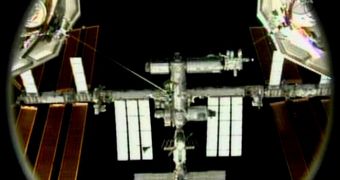At 3:44 am EDT (07:44 GMT) this morning, April 7, the space shuttle Discovery docked to the American berth of the International Space Station (ISS). The intricate maneuver was carried out flawlessly, and therefore the total number of astronauts currently in orbit reached 13 yet again. This flight is special because it represents the first time four women are on the space station at the same time. The seven astronauts aboard Discovery docked just two days after three members of Expedition 23 arrived aboard the Soyuz TMA-18 spacecraft, Space reports.
There were some concerns before the final approach began, as Discovery's main data antenna is currently off-line. It broke down shortly after the orbiter took off from the Kennedy Space Center (KSC), in Florida, and the crew was unable to bring it back up until the rendezvous took place. The antenna usually plays an important role as the spacecraft nears the station, providing a means for relaying radar data between the station and the orbiter. However, the astronauts dealt with the situation without having to use the antenna, and managed to do so without putting a single scratch on the shuttle.
The docking sequence took place in the dark, as the two spacecrafts were flying some 215 miles, or 346 kilometers, above the Caribbeans. At this point, the crews are conducting a number of safety checks before opening the hatches between the two ships, so as to ensure that there are no liquid or gas leakages in the connection. The astronauts will meet up with each other later on today, NASA announces. When the hatch opens, two records will be broken – that of four female astronauts in space, and that of two female JAXA astronauts (the Asian country's only ones) in space at the same time.
As Discovery approached the ISS, it executed the standard back flip maneuver, which is aimed at giving the astronauts aboard the orbital facility the chance to snap additional pictures of the spacecraft's underbelly. These datasets are then usually merged with the ones collected by shuttle crews during the mandatory heat shield inspection, and sent to Mission Control for analysis. Here, these pieces of information are further combined with readings collected from the ground during take-off, and with data that astronauts from the shuttles collected during the final heat shield inspection, after ISS separation. This gives experts at NASA the relevant info to allow for the shuttle to reenter Earth's atmosphere safely.

 14 DAY TRIAL //
14 DAY TRIAL //